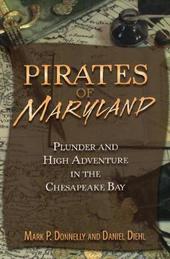
|
Pirates of Maryland: Plunder and High Adventure in the Chesapeake Bay
Paperback
Main Details
| Title |
Pirates of Maryland: Plunder and High Adventure in the Chesapeake Bay
|
| Authors and Contributors |
By (author) Mark P. Donnelly
|
|
By (author) Daniel Diehl
|
| Physical Properties |
| Format:Paperback | | Pages:128 | | Dimensions(mm): Height 210,Width 140 |
|
| ISBN/Barcode |
9780811710411
|
| Classifications | Dewey:975.2 |
|---|
| Audience | |
|---|
| Illustrations |
8 b/w illustrations & 1 map
|
|
Publishing Details |
| Publisher |
Stackpole Books
|
| Imprint |
Stackpole Books
|
| Publication Date |
15 December 2012 |
| Publication Country |
United States
|
Description
Pirates and privateers (thieves who had the blessings of their home countries) were major players in Chesapeake Bay history. For nearly 200 years, pirates roamed the Bay's waters looking for prey and outfitting themselves to search for prizes in other parts of the world. In the early 17th century, pirates settled near the southern portion of the Chesapeake Bay, increasing the possibility of pirate attacks in the region. As the young Virginia colony flourished and commerce with Europe expanded, pirates and privateers found plenty of opportunities to prey upon vessels. The first act of piracy was committed on the Chesapeake in 1635. William Claiborne, who owned a plantation on Kent Island, Maryland, sent his agent to capture a small boat as it approached Palmer's Island at the head of the Bay. Fueled by growing tensions between Maryland and Virginia, Claiborne- a Virginian - was angry that the Maryland boat had invaded his plantation's territory. This event kicked off almost 200 years of piracy on the Bay. Even though they victimized colonial ships, pirates were often tolerated and even courted by governors, merchants and citizens of the colonies. In some ways, supporting piracy marked their growing desire to be independent from England. Pirates sold colonial merchants the black market goods they could not buy from England. Despite their apparent prosperity, most pirates led hard lives and died early. Life aboard pirate vessels was miserable. The wooden ships were dank and moldy, and stank of waste, rotted meat and unwashed bodies. Pirates'work was unending. Half a crew could be lost to disease on a single voyage. If pirates did not succumb to disease, they could easily lose their life or limbs in battle. And, on occasion, punishment awaited them when they returned to shore. The brutal life onboard and the likelihood of injury or death did not dissuade all seamen from becoming pirates. The slim possibility of financial reward was a strong incentive. Although many pirates died with little to their names, others somehow managed to thwart authority and find riches.
Author Biography
Mark Donnelly has collaborated with Dan Diehl on 18 books and more than 100 hours of documentary television, including programs for the Discovery, History, and Biography channels.
|